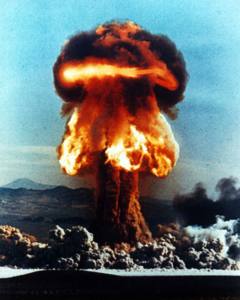
Hair-Trigger Nukes
The cold war is long over, and the United States and Russia are at peace. Yet together they have approximately 4,000 nuclear warheads on hair-trigger alert – weapons with a combined destructive power nearly 100,000 times that of the atomic bomb that leveled Hiroshima are armed and fueled at all times. Their targets – Washington and New York, Moscow and St. Petersburg – have been programmed by internal computers. In the U.S., they will launch on receiving three computer-delivered messages. Launch crews – on duty 24-7 – will send the messages on receipt of a single computer-delivered command.All this information was readily available to journalists if not always staring them in the face. NBC's Tim Russert recognized the peril by making "the threat and prevention of nuclear terrorism" the subject of Meet the Press on May 29, 2005. Among Russert's guests that day were Sam Nunn and Richard Lugar, chairman of the Senate Foreign Relations Committee, who co-authored the Nunn-Lugar Cooperative Threat Reduction Program.
Russert to Nunn: "What about each side having their nuclear weapons on hair-trigger alert?"
Nunn: "Well, that makes no sense . . . particularly from our security point of view . . . because the Russians' radar system and their warning systems have deteriorated substantially, so there's more chance of an accident now. Here again, you've got to have presidential leadership. These changes are not going to bubble up from the bottom. They've got to come from the top."
Lugar's plain – and newsworthy – implication was that Bush does not assign a high priority to reducing the nuclear threat. Yet I could find no U.S. news coverage on any aspect of this survival-of-the-planet edition of Meet the Press. Seven days after the Meet the Press program, a newspaper reported that former Defense Secretary Robert S. McNamara had told a conference earlier in the week, "If I were to characterize U.S. and NATO nuclear policies in one sentence, I would say they are immoral, illegal, and militarily unnecessary." Once the overseer of 30,000 nuclear warheads but now an advocate of disarmament, he described nuclear weapons as "very, very dangerous in terms of the risk of inadvertent or accidental launch."
The newspaper was The Sunday Times. Of London.
U.S. journalism is rightly criticized these days for its broad failure to get beyond the spin, to adjudicate factual disputes, to challenge the official version of truth. This story, though, required none of that. It was simply a matter of reporting what the officials said, and following up.
*Bruce G. Blair, who heads the World Security Institute and is widely considered the nation's foremost authority on nuclear command and control, and others at the institute have warned frequently that ready-to-fire nuclear weapons are susceptible to unauthorized launch by heavily armed terrorists, who might either capture a missile or electronically hack into a missile launch control system. In 2002, for example, Blair cited a "super-secret Pentagon study" that concluded that terrorists could hack the U.S. submarine communications network and "actually transmit a launch order to the Trident fleet.